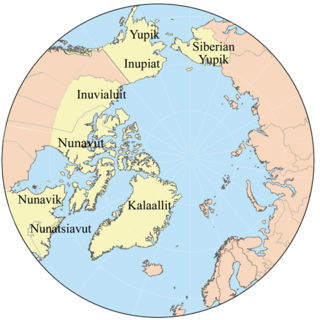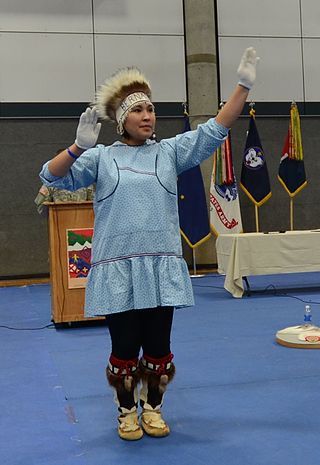Related Research Articles

Eskimo is an exonym used to refer to two closely related Indigenous peoples: Inuit and the Yupik of eastern Siberia and Alaska. A related third group, the Aleut, which inhabit the Aleutian Islands, are generally excluded from the definition of Eskimo. The three groups share a relatively recent common ancestor, and speak related languages belonging to the Eskaleut language family.

The Inuit languages are a closely related group of indigenous American languages traditionally spoken across the North American Arctic and the adjacent subarctic regions as far south as Labrador. The Inuit languages are one of the two branches of the Eskimoan language family, the other being the Yupik languages, which are spoken in Alaska and the Russian Far East. Most Inuit people live in one of three countries: Greenland, a self-governing territory within the Kingdom of Denmark; Canada, specifically in Nunavut, the Inuvialuit Settlement Region of the Northwest Territories, the Nunavik region of Quebec, and the Nunatsiavut and NunatuKavut regions of Labrador; and the United States, specifically in northern and western Alaska.

The Yupik are a group of Indigenous or Aboriginal peoples of western, southwestern, and southcentral Alaska and the Russian Far East. They are related to the Inuit and Iñupiat. Yupik peoples include the following:

The Eskaleut, Eskimo–Aleut or Inuit–Yupik–Unangan languages are a language family native to the northern portions of the North American continent, and a small part of northeastern Asia. Languages in the family are indigenous to parts of what are now the United States (Alaska); Canada including Nunavut, Northwest Territories, northern Quebec (Nunavik), and northern Labrador (Nunatsiavut); Greenland; and the Russian Far East. The language family is also known as Eskaleutian, Eskaleutic or Inuit–Yupik–Unangan.
Central Siberian Yupik, is an endangered Yupik language spoken by the Indigenous Siberian Yupik people along the coast of Chukotka in the Russian Far East and in the villages of Savoonga and Gambell on St. Lawrence Island. The language is part of the Eskimo-Aleut language family.

The Yupik languages are a family of languages spoken by the Yupik peoples of western and south-central Alaska and Chukotka. The Yupik languages differ enough from one another that they are not mutually intelligible, although speakers of one of the languages may understand the general idea of a conversation of speakers of another of the languages. One of them, Sirenik, has been extinct since 1997.

Iñupiaq or Inupiaq, also known as Iñupiat, Inupiat, Iñupiatun or Alaskan Inuit, is an Inuit language, or perhaps group of languages, spoken by the Iñupiat people in northern and northwestern Alaska, as well as a small adjacent part of the Northwest Territories of Canada. The Iñupiat language is a member of the Inuit-Yupik-Unangan language family, and is closely related and, to varying degrees, mutually intelligible with other Inuit languages of Canada and Greenland. There are roughly 2,000 speakers. Iñupiaq is considered to be a threatened language, with most speakers at or above the age of 40. Iñupiaq is an official language of the State of Alaska, along with several other indigenous languages.
The claim that Eskimo words for snow are unusually numerous, particularly in contrast to English, is often used to support the controversial linguistic-relativity hypothesis or "Whorfianism". The strongest interpretation of this hypothesis, which posits that a language's vocabulary shapes or limits its speakers' view of the world, has been largely discredited, though a 2010 study supports the core notion that these languages have many more words for snow than the English language. The original claim is based in the work of anthropologist Franz Boas and was particularly promoted by his contemporary, Benjamin Lee Whorf, whose name is connected with the hypothesis. The idea is commonly tied to larger discussions on the connections between language and thought.

Naukan Yupik language or Naukan Siberian Yupik language is a critically endangered Eskimo language spoken by c. 70 Naukan persons (нывуӄаӷмит) on the Chukotka peninsula. It is one of the four Yupik languages, along with Central Siberian Yupik, Central Alaskan Yup'ik and Pacific Gulf Yupik.
Central Alaskan Yupʼik is one of the languages of the Yupik family, in turn a member of the Eskimo–Aleut language group, spoken in western and southwestern Alaska. Both in ethnic population and in number of speakers, the Central Alaskan Yupik people form the largest group among Alaska Natives. As of 2010 Yupʼik was, after Navajo, the second most spoken aboriginal language in the United States. Yupʼik should not be confused with the related language Central Siberian Yupik spoken in Chukotka and St. Lawrence Island, nor Naukan Yupik likewise spoken in Chukotka.

The Yup'ik or Yupiaq and Yupiit or Yupiat (pl), also Central Alaskan Yup'ik, Central Yup'ik, Alaskan Yup'ik, are an Indigenous people of western and southwestern Alaska ranging from southern Norton Sound southwards along the coast of the Bering Sea on the Yukon-Kuskokwim Delta and along the northern coast of Bristol Bay as far east as Nushagak Bay and the northern Alaska Peninsula at Naknek River and Egegik Bay. They are also known as Cup'ik by the Chevak Cup'ik dialect-speaking people of Chevak and Cup'ig for the Nunivak Cup'ig dialect-speaking people of Nunivak Island.
Nunivak Cup'ig or just Cup'ig is a language or separate dialect of Central Alaskan Yup'ik spoken in Central Alaska at the Nunivak Island by Nunivak Cup'ig people. The letter "c" in the Yup’ik alphabet is equivalent to the English alphabet "ch".
The Ngarnji (Ngarndji) or Ngarnka language was traditionally spoken by the Ngarnka people of the Barkly Tablelands in the Northern Territory of Australia. The last fluent speaker of the language died between 1997 and 1998. Ngarnka belongs to the Mirndi language family, in the Ngurlun branch. It is closely related to its eastern neighbours Binbinka, Gudanji and Wambaya. It is more distantly related to its western neighbour Jingulu, and three languages of the Victoria River District, Jaminjung, Ngaliwurru and Nungali. There is very little documentation and description of Ngarnka, however there have been several graduate and undergraduate dissertations written on various aspects of Ngarnka morphology, and a sketch grammar and lexicon of Ngarnka is currently in preparation.
Alaska Natives are a group of indigenous people that live in the state of Alaska and trace their heritage back to the last two great migrations that occurred thousands of years ago. The Native community can be separated into six large tribes and a number of smaller tribes, including the Iñupiat, Yup'ik, Aleut, Tlingit, Haida, Tsimshian, and others. Even with just a small number of communities that make up the entire population, there were more than 300 different languages that the Natives used to communicate with one another.

Bible translations into Eskimo–Aleut languages include:

A kuspuk is a hooded overshirt with a large front pocket commonly worn among Alaska Natives. Kuspuks are tunic-length, falling anywhere from below the hips to below the knees. The bottom portion of kuspuks worn by women may be gathered and akin to a skirt. Kuspuks tend to be pullover garments, though some have zippers.

Yup'ik doll is a traditional Eskimo style doll and figurine form made in the southwestern Alaska by Yup'ik people. Also known as Cup'ik doll for the Chevak Cup'ik dialect speaking Eskimos of Chevak and Cup'ig doll for the Nunivak Cup'ig dialect speaking Eskimos of Nunivak Island. Typically, Yup'ik dolls are dressed in traditional Eskimo style Yup'ik clothing, intended to protect the wearer from cold weather, and are often made from traditional materials obtained through food gathering. Play dolls from the Yup'ik area were made of wood, bone, or walrus ivory and measured from one to twelve inches in height or more. Male and female dolls were often distinguished anatomically and can be told apart by the addition of ivory labrets for males and chin tattooing for females. The information about play dolls within Alaska Native cultures is sporadic. As is so often the case in early museum collections, it is difficult to distinguish dolls made for play from those made for ritual. There were always five dolls making up a family: a father, a mother, a son, a daughter, and a baby. Some human figurines were used by shamans.
In Eskaleut languages, the dubitative mood is a verb form used for dependent adverbial clauses with the meaning 'whether'. The following example is from North Alaskan Inupiaq:

Yup'ik cuisine refers to the Eskimo style traditional subsistence food and cuisine of the Yup'ik people from the western and southwestern Alaska. Also known as Cup'ik cuisine for the Chevak Cup'ik dialect speaking Eskimos of Chevak and Cup'ig cuisine for the Nunivak Cup'ig dialect speaking Eskimos of Nunivak Island. This cuisine is traditionally based on meat from fish, birds, sea and land mammals, and normally contains high levels of protein. Subsistence foods are generally considered by many to be nutritionally superior superfoods. Yup’ik diet is different from Alaskan Inupiat, Canadian Inuit, and Greenlandic diets. Fish as food are primary food for Yup'ik Eskimos. Both food and fish called neqa in Yup'ik. Food preparation techniques are fermentation and cooking, also uncooked raw. Cooking methods are baking, roasting, barbecuing, frying, smoking, boiling, and steaming. Food preservation methods are mostly drying and less often frozen. Dried fish is usually eaten with seal oil. The ulu or fan-shaped knife used for cutting up fish, meat, food, and such.
Irene Reed, was an American anthropologist, linguist and educator, central in preserving and promoting the Yup'ik language in Alaska.
References
- ↑ Nagai 2006.
- ↑ de Reuse 1988, p. 686.
- 1 2 Mithun 2012.
- ↑ Jacobson 2006, p. 149.
- ↑ Jacobson 1990, p. 276.
- ↑ Nagai 2006, p. 92.